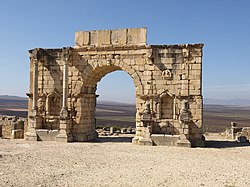Volubilis
| Volubilis archaeological site | |
|---|---|
|
UNESCO world heritage |
|

|
|
| Caracalla arch |
|
| National territory: |
|
| Type: | Culture |
| Criteria : | ii, iii, iv, vi |
| Surface: | 42 ha |
| Reference No .: | 836 |
| UNESCO region : | Arabic states |
| History of enrollment | |
| Enrollment: | 1997 (session 21) |
Volubilis ( Latin ), now Arabic وليلي, DMG Walīlī , is an archaeological site in the Meknes Prefecture area , Morocco . It shows the best preserved monuments from Roman antiquity in this part of North Africa. In 1997 she became a UNESCO - World Heritage Site recognized.
location
The ancient site of Volubilis is about 27 km (driving distance) north of Meknès above the fertile Rharb plain on a southern slope of the water-rich Jbel Zerhoun massif at an altitude of about 380 m above sea level. d. M. and just under 4 km from the small town of Moulay Idris . The city of Fez is about 63 km to the east; the Moroccan capital Rabat is 180 km to the west.
history
The oldest traces of settlement go back to the Neolithic . Like a Punic-Carthaginian inscription from the 3rd century BC. BC proves that there was a settlement on the site of the later Roman city, which was probably called Oualili and maintained close contacts with Carthage . The origin of the name is unknown; maybe it goes back to the Berber word for oleander . A prehistoric burial mound rises in the center of the city.
The city was probably founded around 25 BC. Founded as the second capital under the Mauritanian King Juba II, who grew up in Rome . After the murder of Juba's son and successor Ptolemy, ordered by Emperor Caligula , in AD 40, there was an uprising, as a result of which Volubilis became the provincial capital of the Roman province of Mauretania Tingitana on the southwestern edge of the Roman territory. During Mark Aurel's reign in 168/69, the Hellenistic city fortifications, which enclosed around 15 hectares (the southern, irregularly shaped old town), were replaced by a 2.4-kilometer-long Roman wall with eight gates, which also created a new northeast quarter with a regular arrangement of houses included. The old trade route from Tangier to the southwest now formed the main axis of the city ( decumanus maximus , 400 meters long and 12 meters wide) and no longer ran past it.
The province of Mauretania Tingitana produced an abundance of grain and olive oil, which brought wealth and prosperity to some of the province's large landowners by exporting them to Rome. Another important source of income for the city and for the Berber tribes resident in the area was the export of wild animals ( elephants , lions , leopards , bears ) still living in the north of the Maghreb to the arenas of Rome. The city experienced its heyday with up to 10,000 inhabitants under the emperors Septimius Severus (r. 193 to 211) and Caracalla (r. 211 to 217), who in the Constitutio Antoniniana (212) granted all free male residents of the empire Roman citizenship . Numerous buildings were rebuilt. The main axis was lined with colonnades and shops and houses in the Greek style.
Around the middle of the 3rd century, after some Berber raids, the administrative headquarters were relocated to Tingis (now Tangier ). After being taken by the Berbers, the settlement became the capital of the Auraba Berbers under the name Oualili . After the Romans lost North Africa to the Vandals in the 5th century , Volubilis, unlike many other cities, was not abandoned. The Latin language remained in use here until the Arab conquest in the 7th century. The happy as founder of Morocco primed Idris I. chose walili (or Walīla ) as a residence.
A hammam was found from the Arab period . The last news comes from the chronicler Al Bakri (1068), but there were probably some residents later (refugees from Spain?). Part of the marble was used for the magnificent buildings of Mulai Ismail (r. 1672 to 1727) in nearby Meknes . In 1755 the ruins of the city were again affected by the severe earthquake in Lisbon .
It was not until 1874 that the ruins were identified as the Roman Volubilis. In 1915, French archaeologists began the first excavations - the bronze statues found here are one of the main attractions of the Rabat Archaeological Museum . In 1997, Volubilis was the first pre-Islamic Moroccan cultural site to be recognized as a World Heritage Site.
Attractions
- Basilica (court hall)
- Four thermal baths
- Temple of Saturn
- Capitol
- Caracalla arch, triumphal arch and entrance gate to the city from the 3rd century
- Mosaics (e.g. in the so-called Orpheus House)
- Forum
- Granary
- Oil press (reconstructed)
See also
literature
- Martina Riße (Ed.): Volubilis. A Roman city in Morocco from prehistoric times to the Islamic period . von Zabern, Mainz 2001, ISBN 3-8053-2664-5 .
- M. I, Finley: Atlas of Classical Archeology. Munich 1979, p. 70 f.
Web links
- Volubilis website of the Moroccan Ministry of Culture (English)
- The Volubilis Project (Engl.)
- Pictures of Volubilis (over 140)
Individual evidence
Coordinates: 34 ° 4 ′ N , 5 ° 33 ′ W




